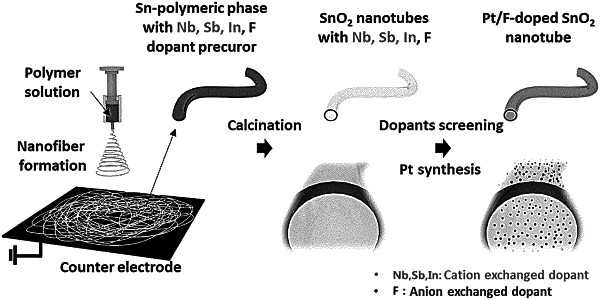| CPC H01M 4/925 (2013.01) [C01G 19/02 (2013.01); D01F 9/08 (2013.01); H01M 4/8673 (2013.01); C01P 2002/54 (2013.01); C01P 2004/13 (2013.01); D01D 5/0007 (2013.01)] | 6 Claims |

|
1. A method for producing a platinum catalyst for a fuel cell, the method comprising:
(a) producing of a solution comprising a tin precursor and a fluorine precursor by comprising:
adding 5% to 17% by weight of the tin precursor based on the total weight of a spinning solvent and 10% to 23% by weight of a nanotube template material based on the total weight of the spinning solvent; and
adding 5% to 40 mol % of a fluorine precursor based on a total number of moles of the spinning solvent;
(b) producing a fluorine-doped tin oxide nanofibers support by electrospinning the solution comprising the tin precursor and the fluorine precursor while injecting the solution at 0.3 ml/h to 0.7 ml/h and applying a voltage of 17 kV to 20 kV;
(c) heat-treating the fluorine-doped tin oxide nanofibers support at 500° C. to 700° C. for 1 to 3 hours in an oxygen or air atmosphere to produce a nanotube, wherein the fluorine is doped at 5 to 8.5 at. % based on the total number of atoms of the fluorine-doped tin oxide nanofibers support; and
(d) supporting platinum nanoparticles on the fluorine-doped tin oxide nanofibers support, and
wherein the nanotube template material comprises one or more selected from the group consisting of polyvinylidene fluoride (PVdF), polyamides (Nylon), polyurethane (PU), polysulfone (PSU), polyacrylonitrile (PAN), polybenzimidazole (PBI), polyaniline (PA), polyimide (PI), polystyrene (PS), polyvinyl chloride (PVC), cellulose acetate, chitosan, silk, collagen, poly-gamma-glutamic acid (PGA), poly lactic acid (PLA), and polycaprolactone (PCL).
|